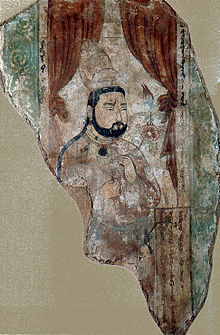Uyghur kaganat
The Uyghur Kaganat was a steppe empire of the Uyghurs in northeast Central Asia .
The Kaganat was founded in 745 as a successor to the second Turk Kaganat and existed until around 840 when it was destroyed by the Kyrgyz . The conversion of many Uyghurs to Manichaeism is historically significant .
Ascent
Under Iltimis Kutluq Bilge-Kül , the Uighurs, who appeared here for the first time as a tribal association, rose up against the Gök- Turks in 744-745 and smashed the already battered second Turk-Kaganat . As a federation of different nomads and settled population groups consisting of nine tribes, they created the Uyghur Kaganat in what is now Mongolia in a succession of local conflicts .
They exercised a kind of supremacy over the neighboring tribes of the Basmıl, Karluken , Türgesch , Oghusen , Tatars , Kitan and Kyrgyz people . Those tribes that refused to submit to them forced the Uyghurs to emigrate. Agriculture and some cities as far as Tuva were recorded . As the political center of their power, the Uighur tribal federation built the oasis city of Karabalgasun (also Ordū-bālīḡ), which was about 320 kilometers west of Ulan Bator and covered an estimated 25 square kilometers.
Climax
Already under the sons of Iltemis, Bilge-Kül [reg. 747-759] and Tengri [reg. 759–779], the Uyghur Kaganat was divided according to ancient nomadic traditions. The capital of the eastern half was the Mongolian Char Balgas , located on the east bank of the Orkhon was. Its ruins have meanwhile been excavated and made famous by a twelve meter high fortress wall. Up to 100,000 people lived there at that time. Tofar was considered the capital of the western empire .
Under Bilge-Kül the Kaganat reached its greatest power. In 758 the Uyghurs defeated a 50,000-strong Kyrgyz army and cut ties between the Kyrgyz empire and Tang China . The mercenary services of the Kaganat for the Tang dynasty ( shaken by the An Lushan uprising) led Tengri to come to China in 762 and convert to Manichaeism with the majority of the nobility . But the Assyrian Church and Buddhism also spread throughout the empire. This made it possible for the Uighurs to expand trade with the Christian Orient. They now adopted the Syriac-Aramaic script and in the following years developed an important literature , such as the work Kutadgu Bilik by Yusuf Has Hajib , which was written between 1069 and 1070.
As before under the Turks, the Sogdians , who were very successful as traders and in administration , played a leading role in the empire . Sections of the nobility, however, did not agree with the Sogdian politics. Thus, under the leadership of Tun Baga Tarkhan, there was an uprising of the nobility, and Tarkhan ordered the assassination (779) of his cousin Tengri Khagan when he refused to disempower the Sogdians. Tarkhan now assumed the title of Alp-Kutluq Bilge. Alp-Kutluq reoriented its policy towards China and murdered numerous Christians.
Decline
In 788, China no longer referred to Alp-Kutluq as a younger brother - that is, a mercenary - but as a half / son-in-law - a close friend . After the death of Alp-Kutluq (789) the Uyghurs temporarily lost political influence. Successor was now Külüg-Bilge (ruled 789/90), and in 790 the underage brother Kutluq-Bilge (790/95) was proclaimed ruler. But the real power lay with General Kutluq, who was considered unsuccessful: All campaigns of 790 were lost for Kutluq. In 795 Külüg-Bilge died without leaving a successor.
General Kutluq took the name Ay-Tengride Ülüg-Bulmis Alp-Kutluq Ulugh-Bilge (r. 795-805) and took power. As early as 791/92 he was able to iron out the defeats of 790 when he conquered several cities in the Tarim Basin from the Tibetans . Ay-Tengride restored the power of the Uighur Empire, from which his successors Ay-Tengride Kut-Bulmis Külüg-Bilge (r. 805-808) and Ay-Tengeride Kut-Bulmis Alp-Bilge (r. 808-821) will continue to live for a long time could. The latter's successor, Kün-Tengride Ülüg-Bulmis Alp-Küchlüg-Bilge (r. 821–824), further expanded the good Sino-Uyghur relations; however, the constant incursions of the Uyghur hordes into China cast dark shadows on these relationships. China was no longer as generous as it once was with its rewards for the Uighur service: Ay-Tengride Kut-Bulmis Alp-Bilge (r. 824–832) had to be given the modest permission to trade horses and with a few bales Satisfy silk.
The End
A hard winter in 839 and a deserter hastened the end: the Uyghur general Külüg Bagha defected to the Kyrgyz in 840 and together with the prince Uje Khan († 847) from the Yaġlaqar clan, the Kyrgyz destroyed the Uyghur empire. Their rulers Kichik-Tegin (r. 839-840) and Ughe-Tegin (r. 840-846) were killed, the surviving Uyghurs scattered - many fled south. The Kyrgyz Empire succeeded the Uighur.
These Uyghurs founded two smaller states, one in today's Xinjiang - the Uighur Empire of Qočo or the second Uighur Empire (856 - 14th century) - and one in today's Gansu Province . The Uyghurs finally settled down, mixed with their neighbors in a city culture and refused to return to the Mongolian steppe.
literature
- Michael R. Drompp: The Uyghur Empire (744-840) . In: Oxford Research Encyclopedia of Asian History Online
- Colin Mackerras: The Uighur Empire According to the T'ang Dynastic Histories. A Study in Sino-Uighur Relations 744-840. Columbia, SC 1973.
Web links
- The rise and fall of the Uighur empire ( Memento from May 16, 2008 in the Internet Archive )
- Marion Linska, Andrea Handl and Gabriele Rasuly-Paleczek: Introduction to the ethnology of Central Asia , script. Vienna, 2003, accessed on January 1, 2020.



